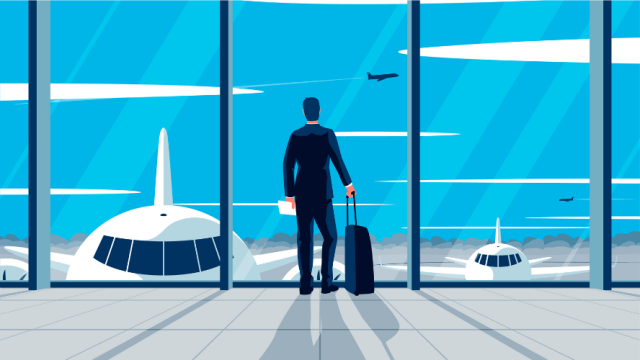There’s a reason the front section of the airplane is called the business class. At least, there used to be.
Business travel was once understood as a necessity. Between 2010 and 2020, business travelers registered an average of 450 million trips per year in the United States alone. As the COVID-19 pandemic brought the world to a grinding halt, business travel slowed with it. Now, signs indicate the downward trend may not be reversing anytime soon.
How does COVID-19 affect business travel? What does the future hold? And what does it all mean for your company? Read on to learn what you need to know about business travel during the pandemic and beyond.
Business Travel News: The Effect of COVID-19
Nearly two years into the pandemic, business travel has not approached pre-pandemic levels— even as leisure travel recovers.
Travelers will book about 1 billion U.S. hotel rooms in 2021, a 20% bump from 2020. However, analysts predict hotel business-travel revenue in 2021 will be $10 billion below 2020 levels. For context, hotel business-travel revenue already dropped $49 billion from 2019 to 2020.
A decrease in hotel bookings is not the only downward indicator for business travel. Air travel overall rebounded over summer 2021, with three times the number of passengers flying between Memorial Day and Labor Day than flew in 2020. But business travel has not seen a similar rise.
Corporate business travel is down 60% from 2019 at one prominent New York-based international travel agency—even as their leisure travel bookings from 2021 eclipsed 2019 numbers. Deutsche Bank expects up to a 50% decrease when comparing 2021 U.S. corporate travel to 2019 levels. In June, Delta Air Lines also reported that corporate revenue was down by 60% compared to 2019. Officials at the airline expected business travel to rise as the summer went on, but the spread of the Delta variant caused them to push back their timeline.
While the exact numbers differ, the statistics all point to one takeaway: business travel shows no signs of recovering anytime soon.
Four Reasons COVID-19 Continues to Slow Business Travel
As countries around the globe implemented social distancing mandates to curb the spread of COVID-19, non-essential travel was largely prohibited. The worldwide shift to remote work made it possible for companies to meet virtually regardless of their geographical location. Business travel, as a result, was often considered non-essential—and fell into a slump.
As countries relaxed social distancing mandates and economies reopened, experts expected business travel to recover. But with numbers continuing to lag, industry insiders now cite several causes.
#1: The Delta Variant Prevents Full Reopenings
For one, the Delta variant has delayed office openings across the country. With many companies still operating remotely, business travelers are often unable to meet representatives from multiple companies in one city. Business trips are therefore less efficient. According to Phillip Baggaley, Chief Credit Analyst of Transportation Companies for Standard & Poor’s, remote work makes it “harder to put together a trip where you see a bunch of different clients.”
#2: Companies Are Wary of Super-Spreader Events
At the same time, companies want to mitigate risk—for both their employees and themselves. Chip Rogers, Chief Executive of the American Hotel & Lodging Association, says that companies are wary of sending representatives to conventions or conferences that might turn into super-spreader events. “It comes down to liability,” Mr. Rogers said.
#3: Virtual Business Is Easier Than Ever
Companies are now also more comfortable doing business virtually, negating a major reason to conduct business travel. In the M&A world, for example, nearly 90% of respondents to a Deloitte survey believe their organizations effectively manage deals in a virtual setting. More than half (55%) think that companies will be more inclined to close deals virtually than in person even after the pandemic. These numbers reflect the business world’s growing comfort with handling all aspects of business online—from closing deals to simply conducting meetings.
#4: Companies Save Time and Money by Limiting Business Travel
Companies also see significant time and money savings from curtailing biz travel. U.S. businesses spend close to $1,000 per traveler on domestic trips. The average cost of an international business trip for U.S. businesses swells to about $2,600 per person. By limiting travel, companies have saved billions during the pandemic—and enjoy the benefits of reinvesting those funds to other parts of their business.
Plus, European employers sending travelers to other EU states need to apply for an A1 certificate to do so, which takes time.
Why Distributed Workforces Help Companies Thrive Without Business Travel
Major companies worldwide plan to continue travel budget cuts after the pandemic. In a recent Bloomberg survey of 45 companies across the U.S., Europe, and Asia, 84% of respondents said they would spend less on travel after the pandemic.
Still, some companies see a need to conduct business face-to-face. Florent Menegaux, CEO of French tire company Michelin, says that his company will continue to facilitate business travel, even if at a decreased rate. “We will continue to travel because human bonds are absolutely necessary to our activity,” Menegaux said.
Other companies need to travel to conduct highly specialized training sessions, conduct sales demos for technical products, or simply honor local customs. In these situations, companies that build a distributed workforce can hold the in-person meetings they need without flying their team members all over the world.
With a distributed workforce, companies are no longer restricted to their home market when building teams. Instead, they engage talent across the world to meet workforce demands in any market. Along with benefits like broadening their talent pools, gaining a recruiting perk, and retaining talent that needs to relocate, companies with a distributed workforce gain a human presence wherever they need one—no business travel required.
Build a Distributed Workforce With the Global Leader
While building a distributed workforce is not an overnight process, working with the right partner makes the process smooth and streamlined. That's where Velocity Global comes in.
Velocity Global has unparalleled expertise and services to help companies secure and manage talent in over 185 countries and all 50 United States, all without going through the costly and inflexible entity establishment process. Our global Employer of Record solutions enables companies to easily:
- Administer payroll across markets
- Offer locally tailored benefits packages
- Manage taxes and withholdings
- Stay compliant with local labor regulations
- Deliver 24/7 workforce support through regional experts worldwide
Ready to discover the benefits of building a distributed workforce in the post-business-travel era? Reach out to Velocity Global today.



